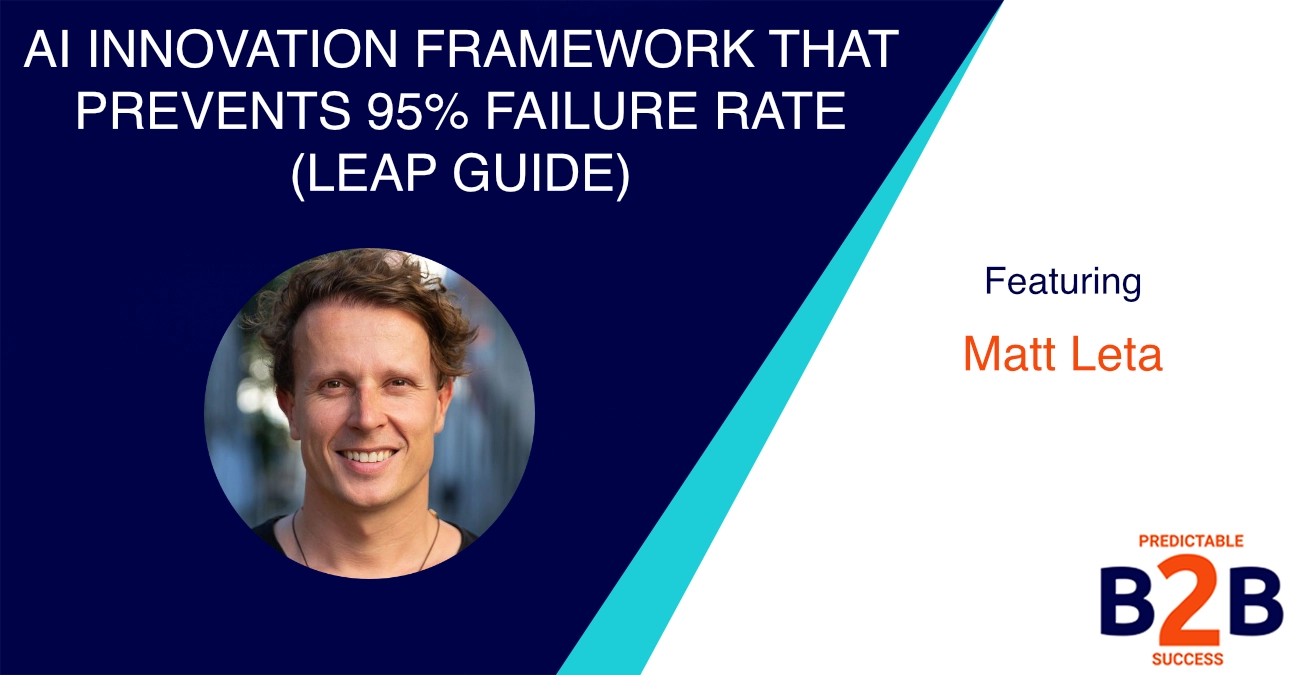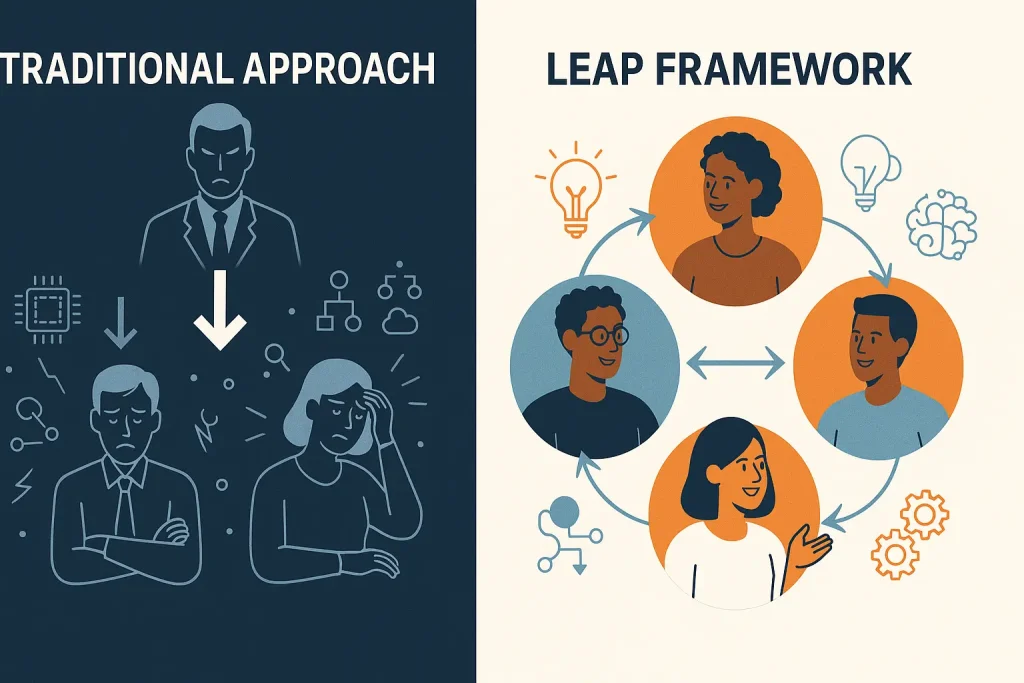
How Smart CEOs Turn AI Project Failures Into 23,000% ROI by Solving the Team Adoption Problem
The brutal truth? Your AI innovation framework is probably doomed before it starts.
While 90% of B2B leaders believe AI will be fundamental to their operations within three years, 95% of enterprise AI pilots fail to deliver measurable ROI. Even more damning: 80% of AI projects fail, double the failure rate of traditional IT initiatives.
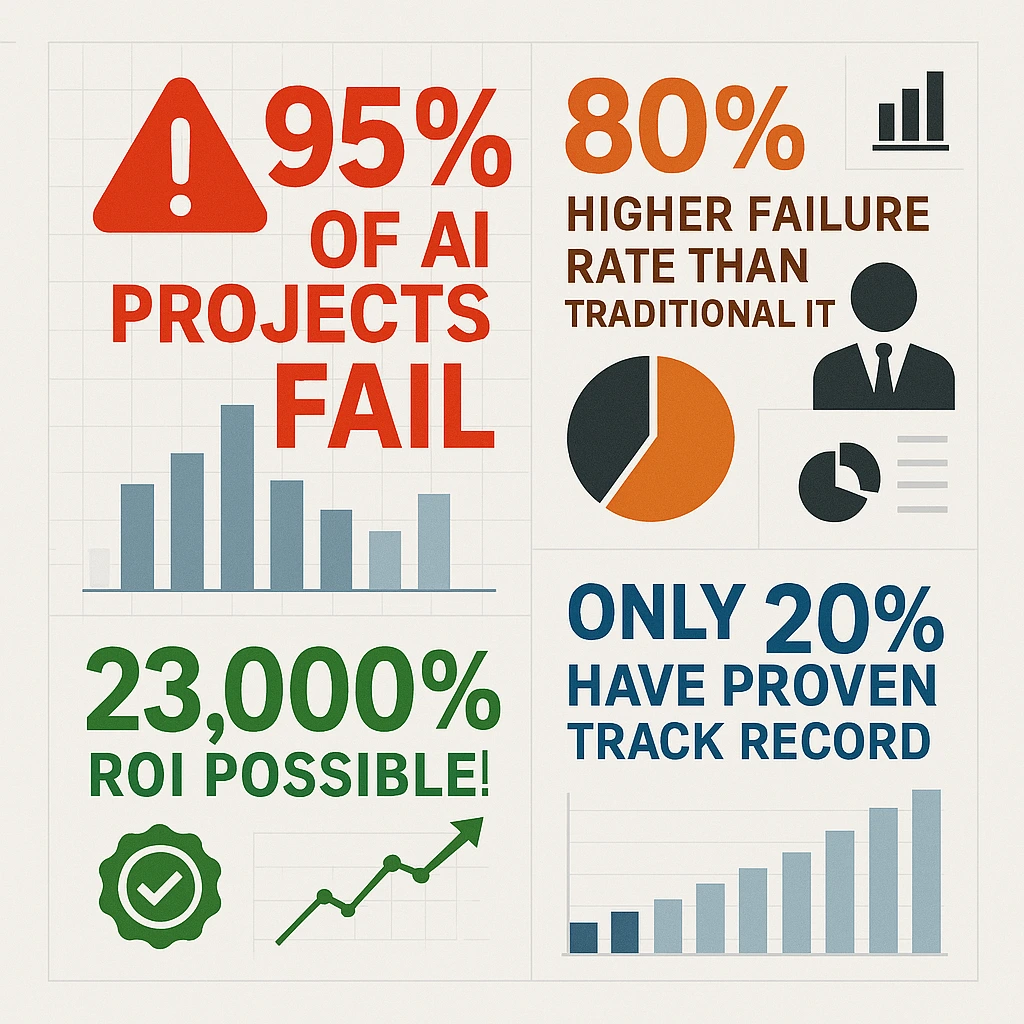
But here’s where most executives get it wrong.
They think the problem is technical. Wrong tech stack. Wrong vendor. Wrong timing.
The real problem? You’re building frameworks that teams actively resist.
Table of Contents
Meet the Executive Who Cracked the AI Adoption Code
Matt Leta knows this pain intimately. As CEO of FutureWorks and bestselling author of “The Leap Guide: 4 Steps to Accelerate Innovation in the Age of AI,” he has spent over 20 years as a digital product innovator, working with companies from Apple and Google to 150+ startups and Fortune 500 organizations.
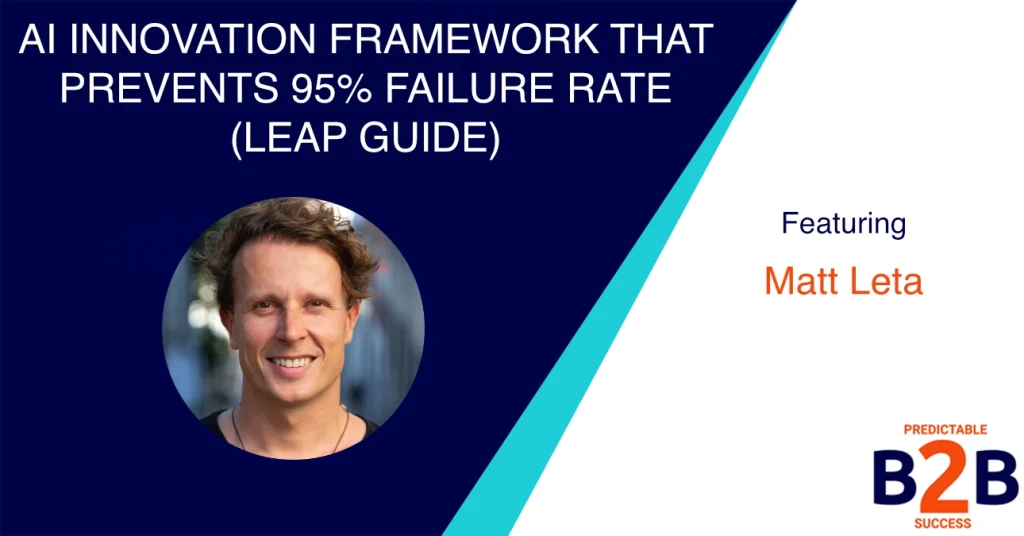
His journey to AI innovation mastery wasn’t typical. After a dramatic exit from his Silicon Valley startup, Leta traveled the world building a remote digital agency that doubled in revenue every year for seven years. But when the 2022 market shift nearly drove the company to bankruptcy, he discovered something remarkable.
“I challenged myself to build a new company on a side in 30 days,” Leta explains. “Part of there was like this thing called hashtag Hustle GPT… I did. And in 20 days it actually, in 30 days or so it became a business running on the side of the bigger one.”
That experiment evolved into FutureWorks and the LEAP framework—a methodology that’s helped clients achieve ROI rates as high as 23,000%. More importantly, it solved the adoption problem that kills most AI initiatives.

Leta’s framework succeeds where others fail because it stops treating AI adoption as a technology problem and starts treating it as a people problem.
Watch the Full Interview: AI Innovation Insights from Matt Leta
Before diving into the specific strategies, watch Matt Leta share his complete insights on building AI innovation frameworks that teams actually embrace. In this in-depth conversation, he reveals the real reasons why most AI initiatives fail and walks through his proven LEAP methodology.
Key topics covered in this interview:
- Why 80%+ of AI projects fail (and it’s not what you think)
- The three critical steps every AI initiative needs
- Real case studies from companies achieving 23,000% ROI
- How to build an innovation culture instead of just deploying technology
- The role of executive sponsorship in AI success
Time investment: 45 minutes | Value: Strategies that could save your organization millions in failed AI initiatives
Matt Leta, CEO of FutureWorks and author of “The Leap Guide,” discovered this after helping 150+ companies implement AI. His most successful client achieved a 23,000% ROI. His secret? He stopped treating AI adoption as a technology problem and started treating it as a people problem.
“Innovation is different from transformation and betterment,” Leta explains. “It basically means having the ability to see what is and to improve it. But times have changed. Those who didn’t really need to think about innovation necessarily now need to because of AI.”
Why Traditional AI Frameworks Fail Teams
Most AI innovation frameworks fail because they’re designed by technologists for technologists. They miss the fundamental reality of organizational behavior.
Consider these common failure patterns I’ve witnessed across B2B tech companies:
The “Innovation Theater” Trap: Companies launch AI initiatives that look impressive in board presentations but solve no real problems. Teams see through this immediately and mentally check out.
The “Expert Dependency” Problem: Frameworks that require data scientists to interpret every insight create bottlenecks. Regular employees can’t participate meaningfully, so adoption stagnates.
The “Big Bang” Mistake: Organizations try to transform everything at once. Teams get overwhelmed, results take too long to materialize, and executives lose patience.
The most damaging pattern? Delegating AI strategy to Chief Innovation Officers or IT heads.
“It needs to be founder, partner, CEO, COO, or a dedicated person with a mandate to run with it,” Leta emphasizes. “Without that leader, nothing will happen.”
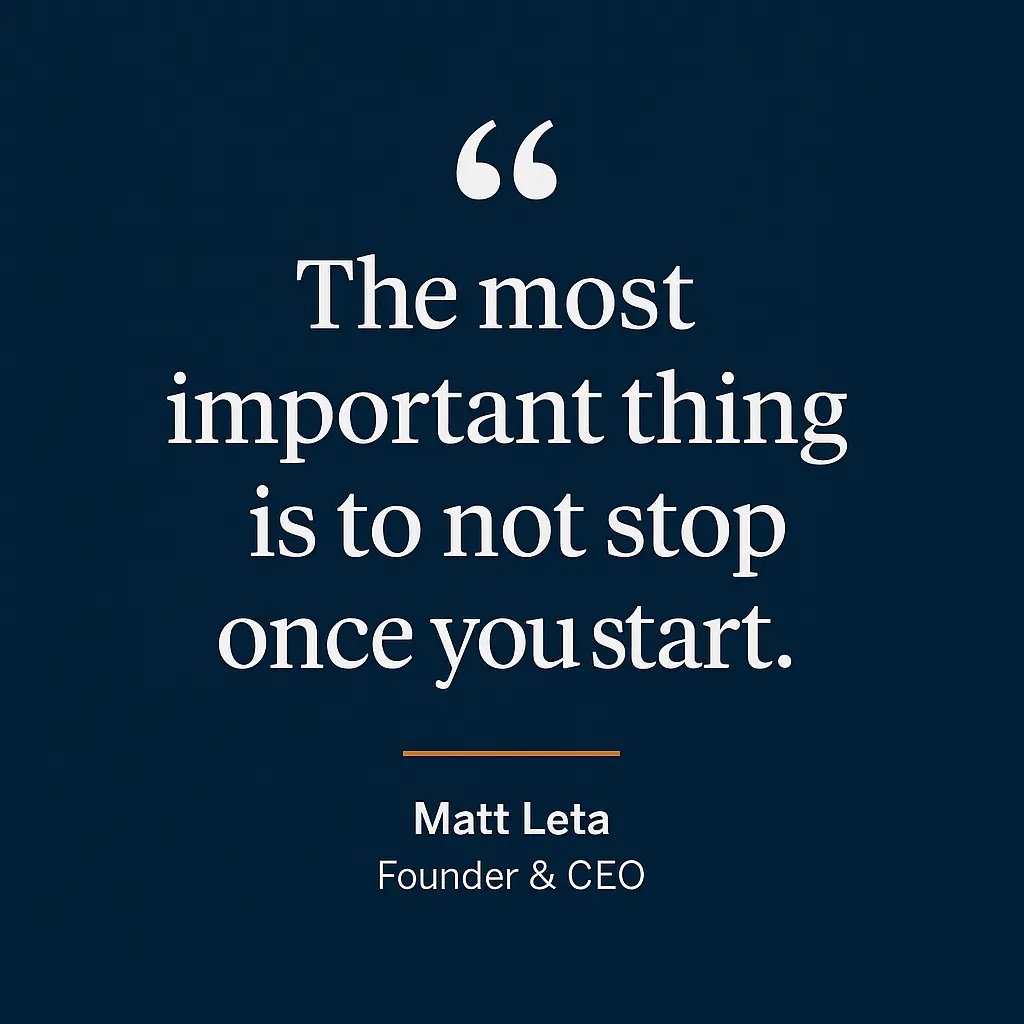
The LEAP Framework: Why Teams Actually Embrace It
Leta’s LEAP framework succeeds where others fail because it’s designed around human psychology, not just technology capabilities.
L – Locate (Weeks 1-4) Teams identify three critical elements: an innovation champion (someone energetic and change-oriented), a diverse group from different departments, and a theme they’ll focus on. Each participant brings 2-3 opportunities per week, building ownership from day one.
E – Evaluate (Week 5) Instead of endless committee discussions, teams use structured evaluation criteria to select one primary opportunity and 5-10 quick wins. The framework prevents analysis paralysis through strict time boundaries.
A – Action Planning (Weeks 6-11) Teams prepare communication materials and execution plans while building internal excitement. This phase focuses heavily on getting stakeholder buy-in and creating momentum that’s harder to stop.
P – Progress (Week 12) Teams deliver a working prototype or meaningful progress. By the end, they’re not asking for permission to start—they’re asking for resources to scale something that’s already working.
The genius? Teams feel like innovators, not order-takers.
“We want to go get all those guys to feel like, okay, this is ours, we’re working with this, it comes from us,” Leta notes. “I think that is something that’s incredibly important today.”
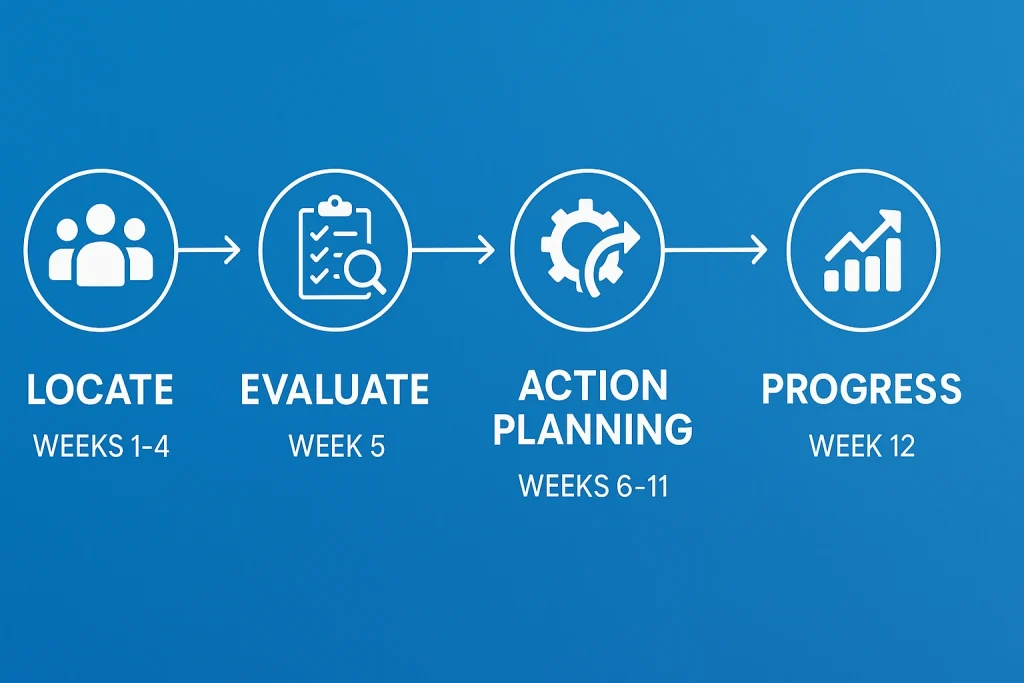
Real ROI: When Teams Drive Innovation
The results speak for themselves. Next Tracker, a solar panel tracking company valued at $6-7 billion, used this approach to solve a logistics nightmare.
The Problem: Installation teams spent three months waiting for parts at solar sites due to a lack of visibility into supply chains.
The LEAP Solution: Teams designed an AI system that gathered available vendor data and used predictive analytics to fill in missing information based on historical patterns.
The Results:
- 10,000+ man-hours saved in the initial pilot period
- 40 customers adopted the system within six months
- The solution became a core software layer, driving significant stock growth.
“It created so much sales pressure that a lot of other people started requesting if they could also have the system,” Leta explains. “The system became like a whole app over time.”
Notice what happened: The innovation didn’t come from executives mandating AI adoption. It came from teams identifying real problems and using AI to solve them.

The Cultural Transformation Secret

Traditional frameworks focus on technology deployment. The LEAP framework focuses on cultural transformation.
Here’s the difference:
Traditional Approach:
- IT department evaluates AI tools
- Executives choose solutions
- Training sessions explain new systems
- Teams comply (reluctantly)
LEAP Approach:
- Teams identify problems they want to solve
- Diverse groups collaborate on solutions
- AI becomes the means, not the end
- Teams become innovation champions
“Over time, what happens is you end up with hundreds of different ideas,” Leta explains. “Of course that’s way too many for any organization to implement. But it provides a database that you can use with AI or hire someone to help organize.”
The framework creates what Leta calls an “innovation culture” where teams feel their ideas matter and they’re part of the solution.
Implementation Strategy: Your 12-Week Roadmap
Weeks 1-4: Locate Phase
- Select an executive champion (not IT or innovation officer)
- Assemble a 5-person diverse team
- Define broad theme (operational efficiency, customer experience, etc.)
- Each member identifies 2-3 opportunities weekly
Week 5: Evaluate Phase
- Use structured criteria to rate all opportunities
- Select 1 primary focus and 5-10 quick wins
- Avoid endless discussion through a strict evaluation framework
Weeks 6-11: Action Planning
- Develop a communication strategy for stakeholders
- Create a detailed execution plan
- Build internal excitement and momentum
- Prepare resource requests with clear ROI projections
Week 12: Progress Phase
- Deliver a working prototype or significant progress
- Demonstrate early wins
- Present the scaling plan to leadership
- Transition from pilot to production
Key Success Factors:
- Executive Championship: The framework only works with true leadership commitment, not delegation.
- No Stopping: “The most important thing is to not stop once you start,” Leta warns. Many initiatives fail when priorities shift or distractions arise.
- Compound Effect: Start small but think big. Each cycle builds capability and momentum for the next.
Measuring Success: Beyond Technology Metrics
Traditional AI frameworks measure technical metrics: model accuracy, processing speed, and data quality.
LEAP measures business impact:
- Cultural Adoption: How many employees actively contribute ideas?
- Problem-Solving Velocity: How quickly teams identify and prototype solutions?
- Stakeholder Buy-in: How enthusiastically does leadership support initiatives?
- ROI Acceleration: How dramatically do business metrics improve?
Leta’s clients typically see results within one quarter, with some achieving transformational changes. “We’ve had projects recently where our ROI was 23,000% on the work we’ve done,” he notes.
But the deeper transformation takes longer. “Within just six weeks you will end up with 25 different marked, understood, analyzed and refined opportunities for innovation. And typically of those, one would be like a bigger project that you want to pursue.”
Common Pitfalls and How to Avoid Them
Based on my experience ghostwriting content for B2B tech startups from seed to Series C, here are the most dangerous pitfalls:
Pitfall 1: Making Innovation Optional: Teams view LEAP participation as an additional task beyond their regular responsibilities. Solution: Make it part of core job responsibilities with dedicated time allocation.
Pitfall 2: Choosing Safe Problems: Teams tend to favor easy, low-impact opportunities. Solution: Incentivize bold thinking and celebrate intelligent failures.
Pitfall 3: Lacking Executive Air Cover: Middle management kills initiatives when competing priorities emerge. Solution: Ensure C-suite visibly participates and protects innovation time.
Pitfall 4: Ignoring Cross-Functional Dynamics: Teams work in silos instead of collaborating across departments. Solution: Mandate diverse participation and reward collaborative solutions.
The Content Strategy Connection
This approach mirrors what I’ve learned building educational email courses for funded B2B tech companies. The most successful content doesn’t push information at audiences—it pulls them into collaborative learning experiences.
Similarly, the most successful AI frameworks don’t push technology at teams—they pull teams into collaborative innovation experiences.
When you’re building AI capabilities, think like a content strategist:
- Start with audience needs (team pain points)
- Create participatory experiences (collaborative problem-solving)
- Build momentum gradually (small wins leading to big wins)
- Measure engagement, not just consumption (active participation vs. passive compliance)
Advanced Scaling Strategies
For organizations ready to scale beyond initial success:
Parallel LEAP Cycles: Run multiple 12-week cycles simultaneously across different departments or themes.
Cross-Pollination Sessions: Create forums where different LEAP teams share insights and combine solutions.
AI-Powered Opportunity Mining: Use AI tools to analyze the growing database of opportunities for patterns and connections.
Leadership Development: Train high-performing LEAP participants to become champions for future cycles.
External Partnership Integration: Connect internal innovation efforts with vendor capabilities and industry best practices.
The Trust Factor in AI Adoption
One underexplored aspect of AI innovation frameworks is trust building. In an era where AI can generate personalized messages at scale for $0.0125 per minute, authentic human relationships become more valuable, not less.
The LEAP framework succeeds partly because it builds trust through transparent collaboration. Teams see exactly how decisions get made and feel ownership over outcomes.
This trust foundation becomes critical when scaling AI initiatives across larger organizations.
The Bottom Line: Innovation as Competitive Advantage
Here’s what 95% of failed AI initiatives miss: Technology is a commodity. Innovation culture is a competitive advantage.
Any company can buy the same AI tools. Not every company can build a culture where teams actively seek ways to improve their work using those tools.
Leta puts it simply:
“We can solve a lot of problems that sometimes people have been grappling with for years. For some clients, we’re solving things that they wanted to implement… for 20 years, but it’s just so difficult.”
The companies that thrive in the AI era won’t be those with the best technology. They’ll be those with the best innovation cultures.

Your Next Steps
Immediate Actions (This Week):
- Identify your executive champion
- Map potential LEAP participants across departments
- Define your initial theme based on urgent business needs
30-Day Milestone: Launch your first LEAP cycle with clear success metrics and a stakeholder communication plan.
90-Day Goal: Complete first cycle with working prototype and plan for scaling to additional teams.
The question isn’t whether AI will transform your industry. The question is whether your teams will drive that transformation or become victims of it.
The LEAP framework gives you the roadmap. Your leadership commitment will determine the destination.
Frequently Asked Questions

What is the main reason AI innovation frameworks fail?
The primary cause of AI project failure isn’t technical—it’s cultural. 95% of enterprise AI initiatives fail because they treat adoption as a technology problem rather than a people problem. Teams resist frameworks that are imposed top-down without their input or understanding of real workplace challenges.
How long does the LEAP framework take to implement?
The LEAP framework operates in efficient 12-week cycles requiring only one hour per week from participants. This minimal time commitment makes it sustainable for busy teams while ensuring consistent progress toward innovation goals.
What ROI can companies expect from proper AI framework implementation?
Companies using the LEAP methodology have achieved ROI rates as high as 23,000%, with most organizations seeing measurable results within one quarter. The framework’s focus on quick wins combined with longer-term initiatives ensures both immediate value and sustained growth.
What makes the LEAP framework different from other AI adoption strategies?
Unlike technology-first approaches, LEAP prioritizes human psychology and organizational change management. It builds an innovation culture from the ground up by making teams feel like innovators rather than order-takers, creating sustainable adoption that scales naturally.
What size team is needed to start the LEAP framework?
The minimum team size is five people, making it accessible to small organizations and individual departments. The framework scales effectively from startups to Fortune 500 companies with 100,000+ employees through parallel implementation cycles.
How do you measure success with the LEAP framework?
Success metrics go beyond traditional technology KPIs to include cultural adoption rates, problem-solving velocity, stakeholder buy-in levels, and business impact acceleration. Teams typically generate 25+ evaluated opportunities within six weeks, with clear pathways for implementation.
What role does executive sponsorship play in framework success?
Executive championship is critical—the framework requires a leader with mandate and authority (founder, CEO, COO, or dedicated executive) who won’t stop when competing priorities emerge. Without this leadership commitment, even the best frameworks fail to achieve lasting impact.
Can the LEAP framework work for companies without AI expertise?
Yes, the framework is designed for organizations at any stage of AI maturity. It includes built-in learning components and focuses on identifying problems first, then finding AI solutions, rather than starting with technology and looking for applications.
Related Resources
Expand your knowledge with these essential guides for B2B growth:
B2B Sales Growth Trends And Strategies: Driving Revenue in 2025
Discover the latest trends driving 19% average revenue growth across B2B organizations and learn proven strategies for sustainable sales acceleration.
Thought Leadership Strategy: A Step by Step Guide For Growth
Build authority and trust that compound growth over time. Learn how to position executives as industry thought leaders through strategic content.
7 Simple Steps to Generate High-Quality B2B Sales Leads
Master the fundamentals of B2B lead generation with proven tactics that consistently attract decision-makers and convert prospects.
How to Boost Lead Generation on LinkedIn With Neuroscience Tweaks
Leverage behavioral psychology principles to dramatically improve LinkedIn outreach performance and relationship building.
Mastering the Art of Copywriting
Learn the psychological principles behind persuasive copy that drives conversions, featuring insights from master copywriter Harry Dry.
Related Links
Connect with Matt Leta and access his resources:
📚 Get the Book:
The LEAP Guide: 4 Steps to Accelerate Innovation in the Age of AI – #1 Bestseller on Amazon with 5-star rating
🌐 Official Website:
leap.guide – Access free AI tools, templates, and resources mentioned in the book
🏢 Company Website:
future.works – Learn about FutureWorks’ next-gen digital transformation services
💼 LinkedIn Profile:
Matt Leta on LinkedIn – Follow for weekly insights from 40,000+ subscriber newsletter
Ready to build an AI innovation framework that teams actually want to use? I help B2B tech companies create the content strategies and executive communication that drive genuine transformation. From educational email courses to LinkedIn content for C-suite leaders, let’s build the narrative that makes innovation inevitable.
Some areas we explore in this episode include:
Listen to the episode.
Subscribe to & Review the Predictable B2B Success Podcast
Thanks for tuning into this week’s Predictable B2B Podcast episode! If the information in our interviews has helped your business journey, please head over to Apple Podcasts, subscribe to the show, and leave us an honest review.
Your reviews and feedback will not only help me continue to deliver great, helpful content but also help me reach even more amazing founders and executives like you!
